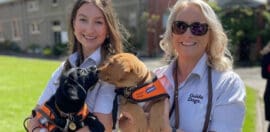Your nature snaps could help restore Australia’s devastated bushland

1 February 2020 at 12:00 pm
The project has received nearly 200 submissions in 24 hours
Australians are being urged to swap Instagram for a new photo sharing platform documenting the recovery of bushfire-affected plants and animals.
Open to anyone in fire-affected regions with a mobile phone, the University of New South Wales (UNSW) project lets “citizen scientists” upload photos of flora and fauna to the iNaturalist mobile app or onto the Environment Recovery Project’s website.
With the bushfires burning an estimated 11 million hectares of land across the country, UNSW scientists hope the photos paint a picture of the current devastation and inform future recovery efforts.
Since launching on Thursday, the project has already received nearly 200 submissions.
New beginnings
For Casey Kirchhoff, PhD candidate at the UNSW Centre for Ecosystem Science and project founder, the motivation behind the project is personal.
After the Southern Highlands’ Morton bushfire destroyed Kirchhoff’s home in Wingello, she started uploading photos of animals and plants to the iNaturalist app that had survived the fires or were quickly coming back to life.
“I took photos of new shoots on ferns and grass trees, wombats in their burrows, glossy black and gang-gang cockatoos in full flight, and brilliant orange fungi dotting the woodland floor,” she said.
But she quickly realised that she couldn’t do it alone.
“I realised I was probably among a handful of scientists collecting this information. So, I thought, why not ask citizen scientists to share their photos?” she said.
“The team at the UNSW Centre for Ecosystem Science aims, with everybody’s help, to build a complete picture of when, where and how Australia’s ecosystems bounce back from these unprecedented fires.”
She said while collecting as much data as possible was important for recovery efforts and future research, getting citizen scientists to share their natural discoveries was about more than just the data.
“Seeing these things gave me hope, but they also highlight the importance of monitoring the recovery of our biodiversity in the wake of the fires,” Kirchhoff said.
Professor Richard Kingsford, the director of the UNSW Centre for Ecosystem Science, said the data would be most useful to see which plant species were resprouting and growing seedlings, when and how animals were returning to burnt areas and which species needed the most help.
“Understanding recovery from this unprecedented fire season is scientifically critical and the opportunity to harness the community’s resources through the Environment Recovery Project is a practical way of doing this” he said.
So how can you help?
First of all, only walk through fire-affected bush that’s safe to do so. From there, all that’s left to do is look for any plant, animal or fungus, snap a pic, and upload it via the app or website.
And if you’re having trouble identifying the species, Kirchhoff said not to worry.
“If you can identify the species do so, but even if you can’t, the photos are still valuable because other people will be able to help. The app will read the image location and allow researchers to identify the particular animal or plant,” she said.
“It would be amazing if thousands of citizen scientists uploaded their images – we look forward to watching the bush recover together.”








